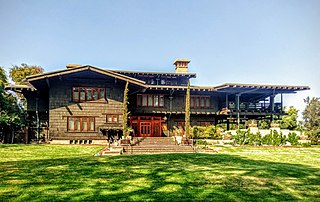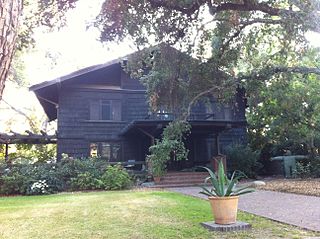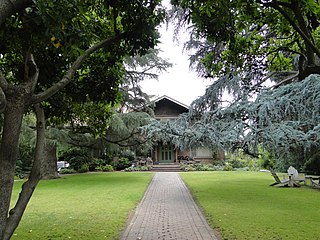
The Gamble House, also known as the David B. Gamble House, is an iconic American Craftsman home in Pasadena, California, designed by the architectural firm Greene and Greene. Constructed in 1908–09 as a home for David B. Gamble of the Procter & Gamble company, it is today a National Historic Landmark, a California Historical Landmark, and open to the public for tours and events.

The Batchelder House is a historic home built in 1910 and located at 626 South Arroyo Boulevard in Pasadena, California. An important center of Pasadena cultural life in its day, the home was designed and built by Ernest A. Batchelder, a prominent leader of the Arts and Crafts Movement, and his wife, Alice Coleman, an accomplished musician. The house, a large bungalow, has a "woodsy" design with elements of a Swiss chalet style. Batchelder's first craft shop was located in the structure, where decorative tiles were made for Greene and Greene, the Heineman Brothers, and other noted local architects of the era. Coleman also used the house's backyard stage to host chamber music concerts.

Henry Weaver House, a California Bungalow, is in Santa Monica, California. It was built in 1910 by the Milwaukee Building Company for Henry Weaver, a Midwestern hotel developer. The house's broad roof overhang, prominent front porch and emphasis on natural colors and materials are unique features of the American Craftsman California Bungalow Style, which "fit the Southland landscape, Southland climate and Southland temperament," according to a 1910 Los Angeles Times article on the Weaver house.

The William R. Thorsen House, often referred to as the Thorsen House, is a historic residence in Berkeley, California. Built in 1909 for William and Caroline Thorsen, it is one of the last of four standing ultimate bungalows designed by Henry and Charles Greene of the renowned architectural firm Greene & Greene and the only one located in Northern California.

The Thomas Gould Jr. House is a historic house located at 402 Lynn Drive in Ventura, California. Architect Henry Mather Greene designed the American Craftsman style California bungalow, which was built in 1924. The house is considered one of the best examples of Henry Greene's independent work; most of his other designs were created alongside his brother Charles as Greene & Greene. The two-story house has a wood frame and redwood siding and window casings. The gable roof features truncated ends and a small gable on the front side which resembles a dormer. The house's interior decorations include ceiling moldings, a leaded glass china cabinet, and a carved mirror, the latter being the only piece of furniture designed by Greene himself.

This is a list of the National Register of Historic Places listings in Pasadena, California.
In the United States, the National Register of Historic Places classifies its listings by various types of architecture. Listed properties often are given one or more of 40 standard architectural style classifications that appear in the National Register Information System (NRIS) database. Other properties are given a custom architectural description with "vernacular" or other qualifiers, and others have no style classification. Many National Register-listed properties do not fit into the several categories listed here, or they fit into more specialized subcategories.

The Lower Arroyo Seco Historic District is a residential historic district in Pasadena, California. The historic district encompasses homes located near the lower Arroyo Seco along Arroyo Boulevard, California Boulevard, La Loma Road, and Grand Avenue. The district includes 78 contributing homes, the majority of which were influenced by the Arts and Crafts movement. During the early twentieth century, when most of the homes in the district were constructed, Pasadena was one of three prominent centers of American Craftsman design, along with Chicago and the San Francisco Bay Area. The district includes a variety of Craftsman designs only matched by one other area in California, a hilly neighborhood in Berkeley. Several prominent architects, including Charles K. Sumner and Henry Mather Greene, designed homes in the district. The Batchelder House, home of tile designer Ernest Batchelder, is included in the district.

The Dr. W. T. Bolton House is a historic house located at 370 W. Del Mar Boulevard in Pasadena, California. Built in 1906, the Craftsman-style house was designed by prominent Pasadena architects Charles and Henry Greene. The house's design emphasizes function over form, a key concept in Craftsman designs; its joints and beams are exposed, and the wooden front door was oiled by hand to highlight its natural grain and color. The house's light fixtures, stained glass windows, and even furnishings were also designed by Greene and Greene to give the house a unified design. Dr. W. T. and Alice Bolton commissioned the house, which was their second residence designed by the Greene brothers; while W. T. Bolton died before he could live in the house, Alice Bolton lived there until 1917. The house was one of several Craftsman homes built in Pasadena's "Millionare's Row" district, which included a number of large homes in the vicinity of Orange Grove Boulevard.

The Louise C. Bentz House is a historic house located at 657 Prospect Boulevard in Pasadena, California. Built in 1906, the bungalow was designed by prominent Pasadena architects Charles and Henry Greene. While the house has a typical bungalow design, its design also exhibits chalet influences in its overhangs and pitched roof and Japanese influences in the edges of the roof and overall horizontal emphasis. The house is the best remaining example of the houses the Greene brothers designed for middle-class Pasadena residents, most of which have been demolished or significantly altered. In addition, the house was the first built in the Prospect Park Tract, a neighborhood of historic homes designed by prominent architects. John Bentz, a significant Pasadena businessman and developer, commissioned the house.

Prospect Historic District is a residential historic district in Pasadena, California, consisting of homes along Prospect Boulevard and several surrounding streets. The district includes 108 residences and roughly encompasses the Prospect Park and Arroyo Park Tracts, a pair of early Pasadena subdivisions. Development on the Prospect Park Tract began in 1904, and the first house was built there in 1906. The Arroyo Park Tract was first surveyed in 1910, and its development soon followed; the two tracts were linked by the Prospect Boulevard Bridge, which was built in 1908. The houses in the district represent a wide variety of architectural styles and include works by several prominent architects, such as Frank Lloyd Wright's Millard House, Charles and Henry Greene's Bentz House, and a 1909 mansion designed by Alfred and Arthur Heineman. The varied architecture of the district's homes is united by its landscaping, particularly through the camphor trees which line its streets.

The Cordelia A. Culbertson House is a historic house located at 1188 Hillcrest Ave. in Pasadena, California. Built in 1911, the house was designed by prominent Pasadena architects Charles and Henry Greene. The Greenes designed the house in the Craftsman style; the design also features Chinese elements throughout, particularly on the south side of the home. Both styles frequently appeared in Greene and Greene's designs, and the house's U-shaped floor plan can also be seen in the brothers' other houses. However, the home features gunite exterior walls and a tile roof, a unique combination among the Greenes' works. An Italian garden is situated at the center of the home. The house was built for Cordelia, Kate, and Margaret Culbertson, three unmarried sisters; Cordelia, the eldest sister, officially commissioned the house. In 1917 the house was purchased by the wealthy widow Mrs. Dudley P. Allen of Cleveland, Ohio. She purchased it as a summer home that she enjoyed with her second husband Francis F. Prentiss, who later died there in 1937.

The House at 530 S. Marengo Avenue is a historic house in Pasadena, California. Built in 1905, the American Craftsman house was designed by Pasadena architect Louis B. Easton. Easton was one of several prominent Craftsman architects in Pasadena in the early 1900s; the house at 530 S. Marengo, located next to his own self-designed house at 540 S. Marengo, was one of his earliest designs. The house features exposed beams and hand-carved joint work in the spirit of the Craftsman style, which emphasized function over form. The interior of the home was inspired by homes in The Craftsman, Gustav Stickley's architecture magazine, which ultimately featured some of Easton's later works.

The South Marengo Historic District is a residential historic district located along South Marengo Avenue in Pasadena, California. The district consists of twelve Craftsman-style bungalows situated on the two blocks between Bellevue Drive and California Boulevard. The homes were built from 1901 to 1916, at the height of the bungalow's popularity in Pasadena. Several prominent local architects designed the homes, including Louis B. Easton, planner of the homes at 530 and 540 South Marengo; Easton's work was featured in Gustav Stickley's magazine The Craftsman. Marengo Avenue was considered an upscale district of Pasadena at the time, partly due to its well-designed homes and partly due to the pepper trees planted along the street.

The Raymond–Summit Historic District is a historic district roughly encompassing the 400 blocks of North Raymond and North Summit Avenues in Pasadena, California. The residential historic district includes 22 contributing buildings. The area was part of Rancho San Pascual prior to its development. In 1875, the Lake Vineyard Land and Water Company formed to manage the property. The company parceled out and sold the land and, between 1886 and 1904, the new owners built houses on their properties during a Pasadena building boom. Architectural styles represented among these homes include Queen Anne, Colonial Revival, American Foursquare, American Craftsman, Shingle Style, and a number of vernacular styles. Prominent Pasadena architects Greene & Greene designed a Shingle Style house at 450 North Raymond and two vernacular cottages at 442 and 448 North Summit; all three houses have Colonial Revival details.

The Ernest W. Smith House is a historic house located at 272 S. Los Robles Ave. in Pasadena, California. Prominent Pasadena architects Greene & Greene designed the American Craftsman house in 1910. The house was one of the last designed by Greene & Greene; however, its simple design is reminiscent of their earlier work. The house's interlocking gable roof with wide eaves was inspired by the Swiss chalet style, a design which Greene & Greene often incorporated into their work. The house's design also features exposed rafter tails, a full-length front porch, casement windows, and a wood shingle roof, all typical elements of Greene & Greene designs.

The Samuel Merrill House is a historic house located at 1285 N. Summit Ave. in Pasadena, California. Noted Pasadena architects Charles and Henry Greene designed the American Craftsman style house, which was built for conservationist Samuel Merrill in 1910. The single-story, "L"-shaped house is built from redwood and Arroyo stone, giving it a natural appearance; it also uses clinker brick for decoration. The house's gable roof features overhanging eaves and exposed rafter tails, characteristic features of Craftsman design. Several pairs of banded casement windows, many with wooden frames, are located throughout the facade. The house is considered one of the best-preserved small houses designed by Greene & Greene.

The Park Place–Arroyo Terrace Historic District is a residential historic district located in northwest Pasadena, California. The district includes eleven contributing houses built from 1902 to 1912. Most of the houses in the district were influenced by the Arts and Crafts Movement, which was popular in Pasadena in the early 20th century; particular styles in the district include the American Craftsman house, the Craftsman bungalow, the Colonial Revival house, and the Prairie School house. Prominent Pasadena architects Charles and Henry Greene designed seven of the district's houses; the district is the most concentrated collection of their works in Pasadena. Two other noted Craftsman architects, Myron Hunt and Sylvanus Marston, also designed homes in the district, including Hunt's own residence.

The Howard Longley House is a historic house in South Pasadena, California, U.S. In 1897, Greene and Greene recorded job no. 23 as a residence for Howard and Etta Longley at 1005 Buena Vista Street, with a valuation of $3,876. Mr. Longley was "the brother-in-law of Dr. Greene's [i.e., Charles and Henry Greene's father] sister, Alice." The house is significant as one of the earliest surviving residences designed by Greene & Greene. On 6 August 1897 the Los Angeles Journal reported that plans for the house were being prepared. The Longley house stands next to the Lucretia Garfield House. The Longley House was listed on the National Register of Historic Places on April 16, 1974.

The Garfield House is a historic two-story house in South Pasadena, California. It was built in 1904 for First Lady Lucretia Garfield, the widow of James A. Garfield who served as the 20th President of the United States in 1881. It was designed by Greene & Greene in the American Craftsman style. It has been listed on the National Register of Historic Places since April 24, 1973.
























